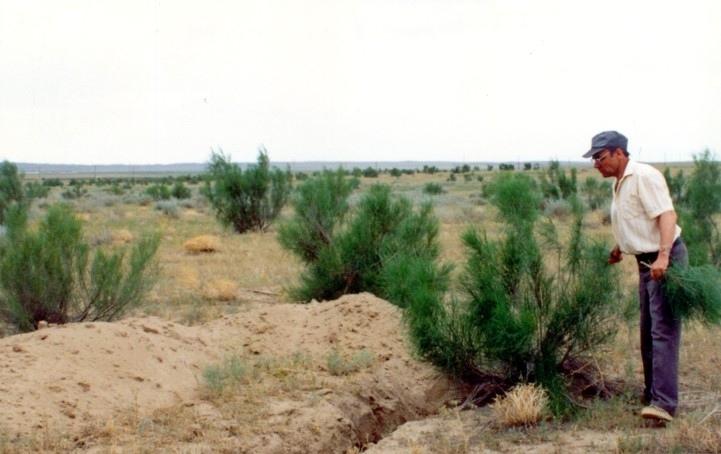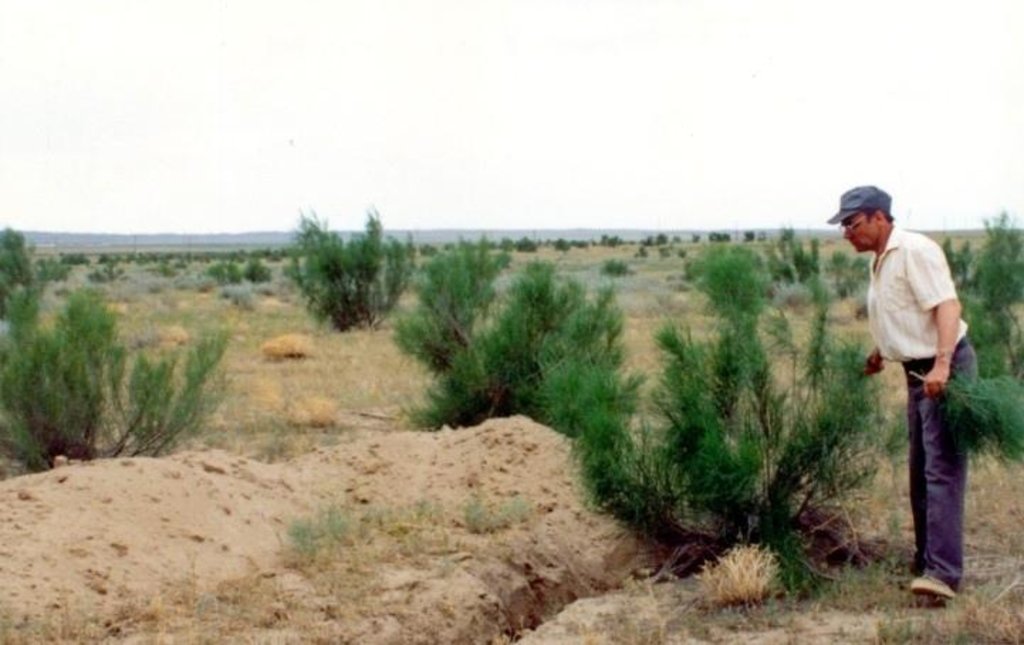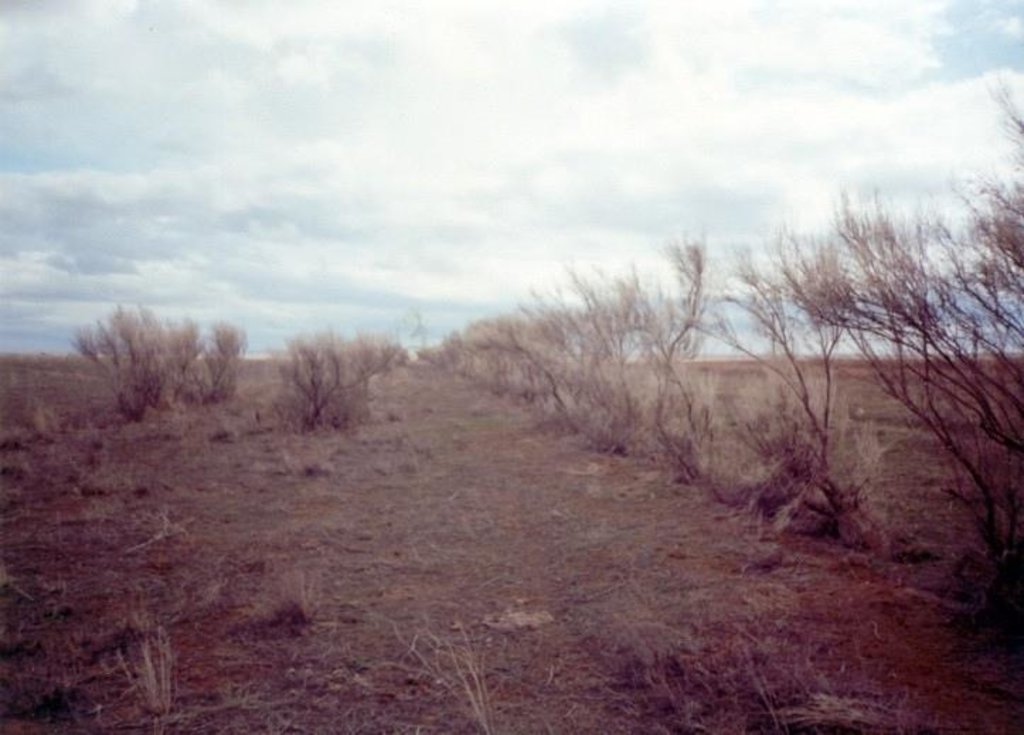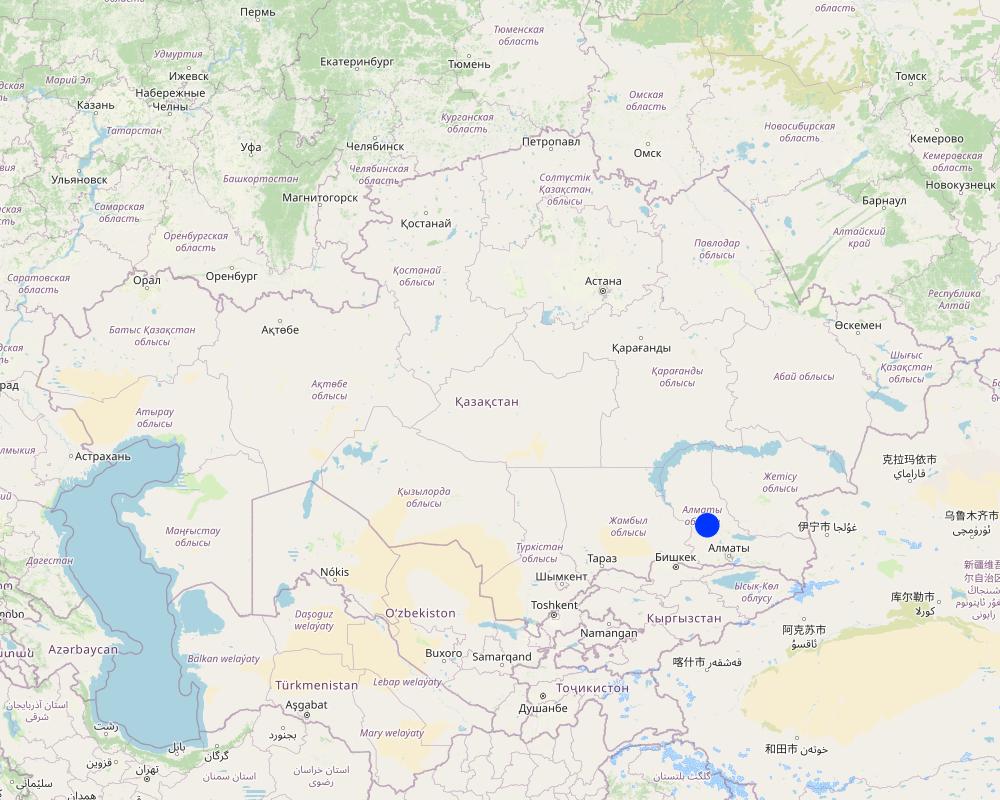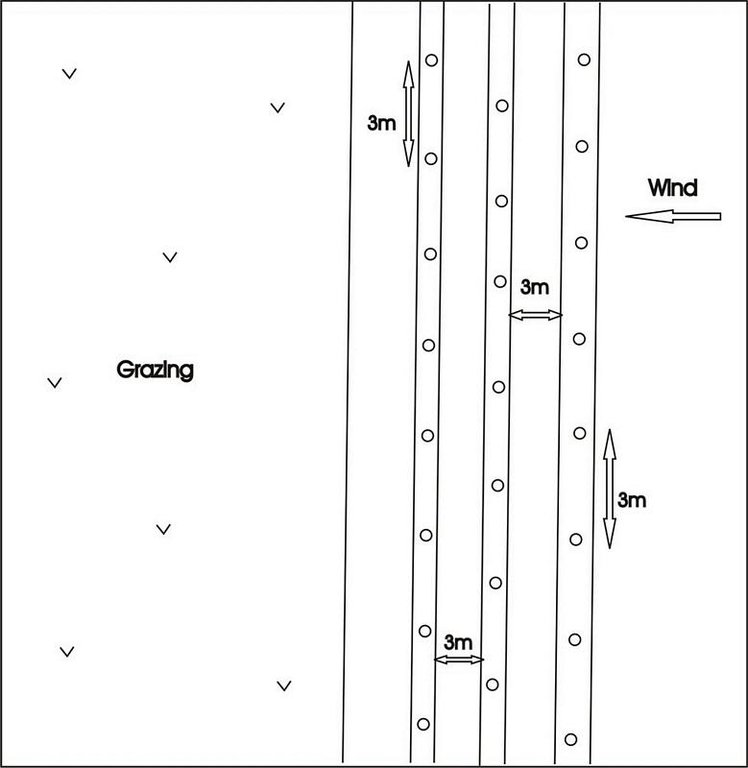Creation of haloxylon pasture-protective strips at north desert [Kazakhstan]
- Creation:
- Update:
- Compiler: Unknown User
- Editor: Hayot Ibrakhimov
- Reviewers: David Streiff, Rima Mekdaschi Studer
Creation of sowed pastures
technologies_1090 - Kazakhstan
View sections
Expand all Collapse all1. General information
1.2 Contact details of resource persons and institutions involved in the assessment and documentation of the Technology
Key resource person(s)
SLM specialist:
Yurchenko Vladimir
SPC for livestock husbandry and veterinary, Ministry of agriculture of the Republic of Kazakhstan
Kazakhstan
SLM specialist:
Alimaev Ilya
SPC for livestock husbandry and veterinary, Ministry of agriculture of the Republic of Kazakhstan
Kazakhstan
Name of the institution(s) which facilitated the documentation/ evaluation of the Technology (if relevant)
Ministry of Agriculture of Kazakhstan (MoA) - Eritrea1.3 Conditions regarding the use of data documented through WOCAT
The compiler and key resource person(s) accept the conditions regarding the use of data documented through WOCAT:
Yes
2. Description of the SLM Technology
2.1 Short description of the Technology
Definition of the Technology:
Localization of erosion processes and moisture accumulation by creation haloxylon strips in pastures of north desert
2.2 Detailed description of the Technology
Description:
1. Pasture-protective haloxylon strips are created by sowing of seeds or planting of seedlings. Strips are three-row with 3 m spacing and 3 m distance between plants.
2. Strips are destined to accumulate a precipitation, decrease wind velocity and localize degradation centers in pastures.
3. Getting the additional feed for agricultural animals and fuel for people .
4. Not more than 500 ha is introduced in South Pribalkhashye.
5. The value of 1 ha of strips is 5500 tenge taking into account a preparation of soil, collection of seeds and sowing. The value of 1 ha of strips, made by planting of seedlings is 7200 tenge.
6. This technology is recommended in north Kazakhstan desert.
2.3 Photos of the Technology
2.5 Country/ region/ locations where the Technology has been applied and which are covered by this assessment
Country:
Kazakhstan
Region/ State/ Province:
Almaty oblast
Further specification of location:
South Pribalkhashye
Specify the spread of the Technology:
- evenly spread over an area
If the Technology is evenly spread over an area, specify area covered (in km2):
5.0
If precise area is not known, indicate approximate area covered:
- 1-10 km2
Comments:
Total area covered by the SLM Technology is 5 km2.
Now the strips created before 1991 remain on hand
Map
×2.6 Date of implementation
If precise year is not known, indicate approximate date:
- more than 50 years ago (traditional)
2.7 Introduction of the Technology
Specify how the Technology was introduced:
- through projects/ external interventions
Comments (type of project, etc.):
SPC for livestock Husbandry and Veterinary of RK
3. Classification of the SLM Technology
3.1 Main purpose(s) of the Technology
- reduce, prevent, restore land degradation
- create beneficial economic impact
3.2 Current land use type(s) where the Technology is applied

Grazing land
Extensive grazing:
- Nomadism

Forest/ woodlands
- Tree plantation, afforestation
Products and services:
- Nature conservation/ protection
- Protection against natural hazards
Comments:
Saxaul pasture protective strips
Major land use problems (compiler’s opinion): The formation of erosion centers in pastures
Major land use problems (land users’ perception): Worsening of abode ecological conditions, forced migrations, increasing of feed capacity of pastures
Grazingland comments: Continuous grazing and unrestricted pasture pressure result in critical situation of degradation at sites around villages and open reservoirs
Type of grazing system comments: Continuous grazing and unrestricted pasture pressure result in critical situation of degradation at sites around villages and open reservoirs
Number of growing seasons per year: 2
Longest growing period in days: 170; Longest growing period from month to month: Apr - Oct; Second longest growing period in days: 45; Second longest growing period from month to month: Sep - Oct
3.4 Water supply
Water supply for the land on which the Technology is applied:
- rainfed
Comments:
Also mixed rainfed - irrigated
3.5 SLM group to which the Technology belongs
- windbreak/ shelterbelt
3.6 SLM measures comprising the Technology

agronomic measures
- A1: Vegetation/ soil cover
- A3: Soil surface treatment
- A4: Subsurface treatment

structural measures
Comments:
Main measures: structural measures
Type of agronomic measures: early planting, minimum tillage, deep tillage / double digging
Type of vegetative measures: aligned: -against wind
3.7 Main types of land degradation addressed by the Technology

other
Specify:
Main causes of degradation: education, access to knowledge and support services (absence of knowledge at farmers on struggle against wind and water erosion)
Secondary causes of degradation: poverty / wealth (lack of captial - small-scale facilities), lack of enforcement of legislat./authority (lack of normative base)
3.8 Prevention, reduction, or restoration of land degradation
Specify the goal of the Technology with regard to land degradation:
- prevent land degradation
- reduce land degradation
Comments:
Secondary goals: prevention of land degradation
4. Technical specifications, implementation activities, inputs, and costs
4.1 Technical drawing of the Technology
Technical specifications (related to technical drawing):
Technology of creation of saxaul pasture protective strips
Technical knowledge required for field staff / advisors: high
Technical knowledge required for land users: moderate
Main technical functions: increase / maintain water stored in soil
Secondary technical functions: reduction in wind speed
Early planting
Material/ species: seeds
Quantity/ density: 25-30kg/ha
Remarks: at right angle to wind direction
Minimum tillage
Remarks: at seeding
Deep tillage / double digging
Remarks: at planting
Aligned: -against wind
Number of plants per (ha): 35-40 thousand units
Spacing between rows / strips / blocks (m): 3
Vertical interval within rows / strips / blocks (m): 3
Width within rows / strips / blocks (m): 3
Other species: haloxylon 35-40 thousand units
4.2 General information regarding the calculation of inputs and costs
Specify currency used for cost calculations:
- USD
Indicate average wage cost of hired labour per day:
4.00
4.3 Establishment activities
| Activity | Timing (season) | |
|---|---|---|
| 1. | Soil preparation | spring |
| 2. | Planting | spring |
| 3. | Cultivating of spacing areas from second year of haloxylon | 2 times in year – spring and autumn |
4.4 Costs and inputs needed for establishment
| Specify input | Unit | Quantity | Costs per Unit | Total costs per input | % of costs borne by land users | |
|---|---|---|---|---|---|---|
| Labour | Soil preparation, planting and cultivating | ha | 1.0 | 9.0 | 9.0 | |
| Equipment | Machine use | ha | 1.0 | 13.0 | 13.0 | |
| Plant material | Seeds | ha | 1.0 | 10.0 | 10.0 | |
| Plant material | Seedlings | ha | 1.0 | 250.0 | 250.0 | |
| Total costs for establishment of the Technology | 282.0 | |||||
| Total costs for establishment of the Technology in USD | 282.0 | |||||
Comments:
Duration of establishment phase: 12 month(s)
4.5 Maintenance/ recurrent activities
| Activity | Timing/ frequency | |
|---|---|---|
| 1. | Soil surface treatment | spring / 1 time. |
| 2. | Sowing | spring / 1 time. |
| 3. | Soil packing | spring / 1 time. |
| 4. | Planting | spring / 1 time. |
| 5. | Cultivating of spacing areas | spring and autumn /each year |
4.6 Costs and inputs needed for maintenance/ recurrent activities (per year)
Comments:
For protection from hot wind for the space 1km
4.7 Most important factors affecting the costs
Describe the most determinate factors affecting the costs:
value of petrol.
5. Natural and human environment
5.1 Climate
Annual rainfall
- < 250 mm
- 251-500 mm
- 501-750 mm
- 751-1,000 mm
- 1,001-1,500 mm
- 1,501-2,000 mm
- 2,001-3,000 mm
- 3,001-4,000 mm
- > 4,000 mm
Specify average annual rainfall (if known), in mm:
227.00
Agro-climatic zone
- arid
North Kazakhstan desert
5.2 Topography
Slopes on average:
- flat (0-2%)
- gentle (3-5%)
- moderate (6-10%)
- rolling (11-15%)
- hilly (16-30%)
- steep (31-60%)
- very steep (>60%)
Landforms:
- plateau/plains
- ridges
- mountain slopes
- hill slopes
- footslopes
- valley floors
Altitudinal zone:
- 0-100 m a.s.l.
- 101-500 m a.s.l.
- 501-1,000 m a.s.l.
- 1,001-1,500 m a.s.l.
- 1,501-2,000 m a.s.l.
- 2,001-2,500 m a.s.l.
- 2,501-3,000 m a.s.l.
- 3,001-4,000 m a.s.l.
- > 4,000 m a.s.l.
Comments and further specifications on topography:
Altitudinal zone: 490-510 m a.s.l
5.3 Soils
Soil depth on average:
- very shallow (0-20 cm)
- shallow (21-50 cm)
- moderately deep (51-80 cm)
- deep (81-120 cm)
- very deep (> 120 cm)
Soil texture (topsoil):
- coarse/ light (sandy)
Topsoil organic matter:
- low (<1%)
If available, attach full soil description or specify the available information, e.g. soil type, soil PH/ acidity, Cation Exchange Capacity, nitrogen, salinity etc.
Soil depth on average: Dust content is up to 80% in autumn
Soil texture (topsoil): Light serozems clay sand
Topsoil organic matter: 0.8-1.2%
Soil fertility is very low since the humus content is 0.8-1.2%
Soil drainage / infiltration is medium beacuse of crushed stone base
Soil water storage capacity is very low. In spring 17-21%, in autumn the producing moisture is lacking
5.6 Characteristics of land users applying the Technology
Market orientation of production system:
- mixed (subsistence/ commercial)
Off-farm income:
- less than 10% of all income
Relative level of wealth:
- poor
- average
Level of mechanization:
- mechanized/ motorized
Indicate other relevant characteristics of the land users:
Population density: 50-100 persons/km2
Annual population growth: 0.5% - 1%
60% of the land users are average wealthy and own 70% of the land.
20% of the land users are poor and own 20% of the land.
20% of the land users are poor and own 10% of the land.
Off-farm income specification: With time the plantings can be used as fuel for community people
5.7 Average area of land used by land users applying the Technology
- < 0.5 ha
- 0.5-1 ha
- 1-2 ha
- 2-5 ha
- 5-15 ha
- 15-50 ha
- 50-100 ha
- 100-500 ha
- 500-1,000 ha
- 1,000-10,000 ha
- > 10,000 ha
Comments:
It is complicated to evaluate the size of grazing land per household because the free grazing is practiced at lands appurtenant to rural akimats
0.5-1 ha is used for technology
5.8 Land ownership, land use rights, and water use rights
Land ownership:
- communal/ village
Land use rights:
- open access (unorganized)
6. Impacts and concluding statements
6.1 On-site impacts the Technology has shown
Socio-economic impacts
Production
fodder production
Comments/ specify:
In spacing areas
fodder quality
Comments/ specify:
In spacing areas
Income and costs
farm income
Comments/ specify:
20%
Socio-cultural impacts
community institutions
Comments/ specify:
Convincing illustrative example
Ecological impacts
Climate and disaster risk reduction
wind velocity
Other ecological impacts
soil fertility
Comments/ specify:
40-50% more in strip zone
biodiversity
Comments/ specify:
Introduction of haloxylon in vegetation community
6.4 Cost-benefit analysis
How do the benefits compare with the establishment costs (from land users’ perspective)?
Long-term returns:
slightly positive
How do the benefits compare with the maintenance/ recurrent costs (from land users' perspective)?
Long-term returns:
slightly positive
6.5 Adoption of the Technology
- > 50%
If available, quantify (no. of households and/ or area covered):
440 households in an area of 5 km2 (50-100 persons/km)
Of all those who have adopted the Technology, how many did so spontaneously, i.e. without receiving any material incentives/ payments?
- 0-10%
Comments:
430 land user families have adopted the Technology with external material support
Comments on acceptance with external material support: survey results
40% of land user families have adopted the Technology without any external material support
10 land user families have adopted the Technology without any external material support
Comments on spontaneous adoption: survey results
There is a moderate trend towards spontaneous adoption of the Technology
Comments on adoption trend: all of groups of community people are interested in use of the technology
6.7 Strengths/ advantages/ opportunities of the Technology
| Strengths/ advantages/ opportunities in the land user’s view |
|---|
| increase of pasture capacity |
| improvement of ecological conditions in places of abode |
| increase of living standards |
| Strengths/ advantages/ opportunities in the compiler’s or other key resource person’s view |
|---|
|
shortening of possibilities of dust storms in degraded pastures How can they be sustained / enhanced? all advantages can be sustained for 30 and more years |
| possibility of fuel storage in woodless areas of desert |
| increase of pasture capacity |
| Influence on culture standard of people |
7. References and links
7.1 Methods/ sources of information
Links and modules
Expand all Collapse allLinks
No links
Modules
No modules


